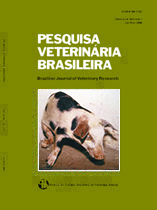 |
|
|
|
Year 2017 - Volume 37, Number 6
|

|
Immunohistochemical, lectin histochemical and ultrastructural studies of canine transmissible venereal tumor in Brazil, 37(6):613-620
|
ABSTRACT.- Mascarenhas M.B., Peixoto P.V., Ramadinha R.R., Armién A.G., Costa S.Z., Miranda I.C., Nogueira V.A. & França T.N. 2017. Immunohistochemical, lectin histochemical and ultrastructural studies of canine transmissible venereal tumor in Brazil. Pesquisa Veterinária Brasileira 37(6):613-620. Programa de Pós-Graduação em Medicina Veterinária, Universidade Federal Rural do Rio de Janeiro, BR-465 Km 7, Seropédica, RJ 23890-000, Brazil. E-mail: mm.bezerra@yahoo.com
Canine transmissible venereal tumor (CTVT) is a naturally occurring contagious round-cell neoplasia, with poorly understood origin and transmission. This study aims to further investigate the tumor nature through immunohistochemistry, lectin histochemistry and transmission electron microscopy (TEM) analysis, and to provide support for diagnostic and differential diagnoses of CTVT. Immunohistochemistry was performed in 10 genital and six exclusively extragenital tumors, which were previously diagnosed by citology and histopathology. CTVT samples were incubated with biotinylated antibodies to specific membrane and cytoplasmic antigens (anti-lysozyme, anti-macrophage, anti-vimentin, anti-CD18, monoclonal anti-CD117, monoclonal anti-CD3, polyclonal anti-CD117, polyclonal CD3 and anti-CD79a), followed by the avidin-biotin-peroxidase complex technique. The lectins Con A, DBA, SBA, PNA, UEA-1, WGA, sWGA, GSL, JSA, PSA, PHA-L, PHA-E and RCA were additionally tested in four genital CTVTs and TEM was performed in eight genital tumors. The anti-vimentin antibody revealed strong immunoreactivity to neoplastic cells in all the assessed samples (16/16). The polyclonal anti-CD3 antibodies showed moderate to strong immunoreactivity in fourteen (14/16) and the polyclonal anti-CD117 in fifteen cases (15/16). There was no immunoreactivity to anti-lysozyme, anti-macrophage, anti-CD18, monoclonal anti-CD117, monoclonal anti-CD3 and anti-CD79a antibodies. At lectin histochemistry, it was observed strong staining of tumor cells to Con-A, PHA-L and RCA. There was no histopathological and immunoreactivity differences between genital and extragenital CTVTs. These findings do not support the hypothesis of histiocytic origin of CTVT. In contrast, the lectin histochemical results were similar to cells from lymphoid/myeloid origin. |
| |
|
|
| |
|
 |